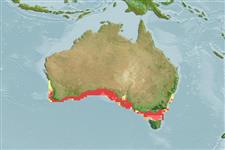Common names from other countries
分類 / Names
俗名 | 同種異名 | Catalog of Fishes(屬, 種) | ITIS | CoL | WoRMS | Cloffa
Teleostei >
Eupercaria/misc (Various families in series Eupercaria)
鱸形目 (Various families in series Eupercaria) >
Sillaginidae (Smelt-whitings)
沙鮻科 (Smelt-whitings)
Etymology: Sillaginodes: See Sillago + Greek, oides = similar to.
More on author: Cuvier.
Environment: milieu / climate zone / depth range / distribution range
生態學
海洋; 半鹹淡水 居於水底的; 非遷移的; 深度上下限 2 - 200 m (Ref. 6390), usually 2 - 18 m (Ref. 6205). 亞熱帶的; 29°S - 41°S, 112°E - 152°E (Ref. 6205)
Indo-West Pacific: southern Australia.
印度-西太平洋: 澳洲南部。
Length at first maturity / 大小 / 重量 / 年齡
Maturity: Lm 34.0, range 32 - 36 cm
Max length : 72.0 cm TL 雄魚/尚未辨別雌雄; (Ref. 6205); common length : 35.0 cm TL 雄魚/尚未辨別雌雄; (Ref. 9563); 最大體重: 4.8 kg (Ref. 6205); 最大年齡: 15 年 (Ref. 6390)
背棘 (總數): 12 - 14; 背的軟條 (總數): 25-27; 臀棘 2; 臀鰭軟條: 21 - 24. The swim bladder is very elongate with a single slender tapering posterior extension and two anterolateral extensions. No duct-like urogenital aperture is present. Body color is pale brown, gray brown, or dark olive green above, and whitish pale brown or silvery below with reflections of mauve, blue green when fresh. The back and upper sides with oblique rows of small round dark brown to rusty brown spots; the lower sides with open-spaced rather scattered round dark spots. The belly is white and without spots. The dorsal fins are uniformly dark greenish brown to light brown sometimes spotted with dark brown; the anal, pectoral and pelvic fins are pale brown to hyaline; the caudal fin is greenish to brownish and finely dusted with brown (Ref. 6205).
泳鰾非常長的具有一個單一細長的尖端細的在後部的延長與二前外側的延長。 沒有像輸送管一樣的泌尿生殖器的孔存在。 體色是白褐色, 灰色褐色, 或深橄欖綠色的上方與微白色的白褐色或下面銀色的具有淡紫色的反光, 藍色的綠色新鮮時。 背部而且上側面有列斜的小圓的深褐色的對赭褐色斑點; 下面的側邊具有開放的-有間隔的相當分散的深色圓斑。 腹面是白色的而且沒有斑點。 背鰭是全黑色綠褐色的到淡褐色有時斑點深褐色的; 肛門者, 胸鰭與腹鰭是白褐色到透明的; 尾鰭是呈綠色到褐色的而且細地有褐色色暈了.(參考文獻 6205)
Inhabit shallow inner continental shelf waters, including bays and inlets (Ref. 6390). For their first few years, they live mainly where seagrasses (Zostera species, Posidonia creeks. Small juveniles favor water depths from 2 m to 20 m. Adults inhabit more exposed waters along coastal beaches and reef areas (Ref. 27008, 27667), sometimes to depths as great as 200 m. Spawn in offshore waters from late summer to winter (Ref. 6390). Juveniles feed on benthic amphipods and other crustaceans. As they grow larger, their diet expands to include polychaete worms, mollusks and peanut worms (Sipuncula) (Ref. 27008, 27667). Oviparous (Ref. 205). This premium quality fish obtains a high price (Ref. 6205).
棲息於水淺的大陸棚內側水域, 包括灣內。 (參考文獻 6390) 他們的最初幾年,他們主要地生活在哪裡海草 ( Zostera 種, Posidonia 小溪。 小的稚魚喜歡從 2 公尺到 20 公尺的水深度。 成魚棲息於更多的裸露水域沿著海岸的海灘與礁區 (參考文獻 27008,27667), 有時到深度深達 200 公尺。 產卵於從夏末到冬天的離岸水域中。 (參考文獻 6390) 稚魚吃底棲的片腳類動物與其他的甲殼動物。 當他們生長比較大, 他們的食性擴展到包括多毛類的蠕蟲,軟體動物與星蟲 ( Sipuncula).(參考文獻 27008,27667) 這個高品質的魚獲得高的價格。 (參考文獻 6205)
Life cycle and mating behavior
成熟度 | 繁殖 | 產卵場 | 卵 | 孕卵數 | 仔魚
Are serial batch spawners, yet the number of spawnings in a season is unknown (Ref. 6390).印度-西太平洋: 澳洲南部。
McKay, R.J., 1992. FAO Species Catalogue. Vol. 14. Sillaginid fishes of the world (family Sillaginidae). An annotated and illustrated catalogue of the sillago, smelt or Indo-Pacific whiting species known to date. Rome: FAO. FAO Fish. Synop. 125(14):87p. (Ref. 6205)
CITES (Ref. 128078)
Not Evaluated
人類使用
漁業: 商業性; 養殖: 實驗的; 游釣魚種: 是的
更多資訊
參考文獻養殖養殖資訊品種遺傳學Electrophoreses遺傳率疾病加工Mass conversion
合作者照片Stamps, Coins Misc.聲音神經毒速度泳型鰓區Otoliths腦重體重比眼睛色素
工具
特別的報告
下載 XML
網路資源
Estimates based on models
Preferred temperature (Ref.
115969): 15.3 - 18.5, mean 17.4 (based on 253 cells).
Phylogenetic diversity index (Ref.
82804): PD
50 = 1.0000 [Uniqueness, from 0.5 = low to 2.0 = high].
Bayesian length-weight: a=0.00501 (0.00258 - 0.00973), b=3.07 (2.90 - 3.24), in cm Total Length, based on LWR estimates for this species & (Sub)family-body (Ref.
93245).
營養階層 (Ref.
69278): 3.3 ±0.3 se; based on diet studies.
回復力 (Ref.
120179): 中等的, 族群倍增時間最少 1.4 - 4.4年 (K=0.47; tm=3-4; tmax=15; Fec=100,000).
Fishing Vulnerability (Ref.
59153): Moderate to high vulnerability (50 of 100).
